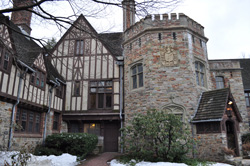Archive
2nd North American Materials Education Symposium, 2011
An event for undergraduate materials teaching across engineering, science, and design
Worcester Polytechnic Institute,
Worcester, MA, March 24-25, 2011
63 people from 17 states and four countries gathered in Worcester for the 2nd North American Materials Education Symposium. This year the Symposium was coordinated by Granta Design, with support from an Academic Advisory Committee, ASM International, the ASEE Materials Division, SEFI, FEMS, TMS, and Worcester Polytechnic Institute.
Presentations and posters were relevant to topics including materials science, manufacturing and process, mechanical engineering, industrial design, architecture, aerospace and nuclear engineering, bio engineering, plastics and sustainability. Discussion sessions, networking opportunities, a poster session, and a social program based near the campus made the event interactive, with plenty of opportunities to meet people and exchange ideas. On the night before the Symposium, the speakers gathered for a dinner at Higgins House, getting the discussions off to an early start and setting a collaborative tone for the event. After the first day, attendees had dinner at the nearby Beechwood Hotel; both socializing and discussion from the day’s sessions spilled over into the early hours.
Symposium Report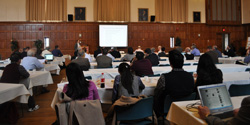
Day One: Engaging and inspiring students, and the use of Information Technology
The first session, chaired by Rick Sisson, offered a stimulating set of talks from a cross-section of experiences, looking at how best to engage and inspire students. Project based learning and interdisciplinary teaching were widely discussed, whilst questions of pedagogical understanding were hotly disputed.
 Each speakers provided an insight into their ideas for increasing engagement and inspiration. For example, Diran Apelian used his opening talk to describe the way 'Great Problem Seminars' offered first year students a 'GPS' to navigate their educational journey with purpose, while Yvonne Traynham discussed the way in which design projects foster the critical thinking needed to motivate students to master theory. All eyes were on John Nychka as he engaged the audience with his ‘what’s-in-the-box’ demo kit, developed to allow hands on experience for first years in the face of limited resources.
Each speakers provided an insight into their ideas for increasing engagement and inspiration. For example, Diran Apelian used his opening talk to describe the way 'Great Problem Seminars' offered first year students a 'GPS' to navigate their educational journey with purpose, while Yvonne Traynham discussed the way in which design projects foster the critical thinking needed to motivate students to master theory. All eyes were on John Nychka as he engaged the audience with his ‘what’s-in-the-box’ demo kit, developed to allow hands on experience for first years in the face of limited resources.
We also heard about a range of approaches being used to tackle the cross-disciplinary nature of engineering and materials education: Ronald Kander & Amanda Kuhnley talked about a experiences with a newly developed interdisciplinary bachelor degree, whilst Cameron Turner described the deeper understanding of disciplinary approaches to design offered by interdisciplinary senior design projects. Advances in IT are now making the sharing of teaching materials across different disciplines more routine, as well as allowing for increased remote-learning. This also brings many challenges, not least preserving the relevance of the course to the individual students. As Mike Rigsbee commented, frequent communication is the single most important factor in making such methods effective.
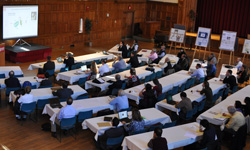 During the discussions on interdisciplinary teaching and design projects many speakers had demonstrated their use of IT as a vehicle for delivering projects. These digital approaches make use of the 'native language' of the current generation of students. As Luis Trueba emphasized, today's students expect to be able to acquire information in a 'just-in-time' manner, consistent with their social use of IT and the Internet. Naturally, the discussion session (chaired by Mark De Guire) addressed whether this is really the best way to deliver teaching.
During the discussions on interdisciplinary teaching and design projects many speakers had demonstrated their use of IT as a vehicle for delivering projects. These digital approaches make use of the 'native language' of the current generation of students. As Luis Trueba emphasized, today's students expect to be able to acquire information in a 'just-in-time' manner, consistent with their social use of IT and the Internet. Naturally, the discussion session (chaired by Mark De Guire) addressed whether this is really the best way to deliver teaching.
A repeated theme (raised, for example, by Greg Olson in his opening talk) was the benefits seen to students at all stages of their studies when they were encouraged to prepare material for use with students in more junior years. This helps inspire the freshmen and sophomores, and helps crystallize understanding in more advanced students.
One of the emergent themes was the way in which students can use IT to tackle the issue of translating design problems into selection requirements. Some, such as Mary Vollaro, appreciated being able to use software such as CES EduPack to help drill down to the underlying theories behind a property. A helpful approach, highlighted by Rudy Buchheit, is to expand student's notions of design with real-world interdisciplinary projects: he pushes students beyond their engineering-centered learning experience by asking them to capture an architect’s inspiration using rigid engineering principles.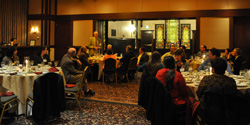
The formal part of the day concluded with more lively discussion, drawing on the many issues raised in the presentations, not least how to assess when a course is being delivered successfully. The atmosphere was engaging and supportive, allowing for a free flow of ideas. Discussions didn't stop at the close of the session, indeed they continued through the formal dinner and into the night.
Day Two: Interdisciplinary materials teaching, and 'Materials and the Environment'
 The collaborative atmosphere established on day one continued as attention focused on interdisciplinary teaching and environmental sustainability in the sessions chaired by Trevor Harding and Diran Apelian. Materials science, as Mike Ashby argued in his opening talk for the morning, is a bridging discipline (see figure, right), linking the pure and applied sciences across many fields. He contended that overarching "Grand Challenges” could bring about the interdisciplinary thinking that can help achieve the balance between breadth and depth required for today's engineers. Mark DeGuire talked about the benefits of tapping into students’ existing interest in environmental issues, while several speakers emphasized that the next generation of engineers will have to face the challenging task of balancing environmental concerns against economic objectives.
The collaborative atmosphere established on day one continued as attention focused on interdisciplinary teaching and environmental sustainability in the sessions chaired by Trevor Harding and Diran Apelian. Materials science, as Mike Ashby argued in his opening talk for the morning, is a bridging discipline (see figure, right), linking the pure and applied sciences across many fields. He contended that overarching "Grand Challenges” could bring about the interdisciplinary thinking that can help achieve the balance between breadth and depth required for today's engineers. Mark DeGuire talked about the benefits of tapping into students’ existing interest in environmental issues, while several speakers emphasized that the next generation of engineers will have to face the challenging task of balancing environmental concerns against economic objectives.
Whilst there was overall consensus of the importance of delivering teaching on 'materials and the environment', one of the key topics for discussion was whether or not it was practical, or indeed beneficial, to do so across the whole curriculum rather than in separately designated courses. As the discussions (chaired by Trevor Harding), turned to course development, it was asked at what stage should the underlying scientific principles be taught in order to best guide an appreciation of materials science’s role in many key areas of sustainability?
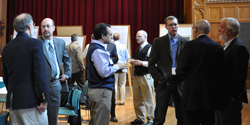 John Abelson echoed the need to address both the breadth of multidisciplinary understanding and depth of intellectual rigour in the teaching of environmental concepts in his opening talk for the final session (chaired by Diran Apelian). Practical experiences were shared by a number of speakers, with approaches including reverse engineering projects to encourage a more detailed understanding of the design process, as well as an engaging set of talks on the contextualisation of the impact of materials on the environment through the use of familiar products such as mobile phones.
John Abelson echoed the need to address both the breadth of multidisciplinary understanding and depth of intellectual rigour in the teaching of environmental concepts in his opening talk for the final session (chaired by Diran Apelian). Practical experiences were shared by a number of speakers, with approaches including reverse engineering projects to encourage a more detailed understanding of the design process, as well as an engaging set of talks on the contextualisation of the impact of materials on the environment through the use of familiar products such as mobile phones.
As the Symposium drew to a close, it was clear that opinion was still divided on whether these themes should be taught from within a materials spine or as standalone issues. However, the openness of these debates, and the sense of collaboration and sharing of ideas, made it clear that everyone was very grateful for this opportunity to focus entirely on materials education. The Chairs were keen to thank the Advisory Committee for putting together such an interesting program, Granta Design for coordinating the event, and for the support of ASM International, the ASEE Materials Division, SEFI, FEMS, TMS, and Worcester Polytechnic Institute.
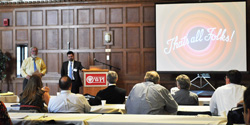
Posters and Courses
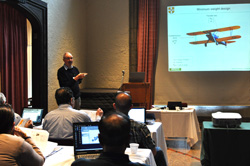 The interactive nature of the event was enhanced by the well attended two-day poster session and social program, encouraging networking and a strong sense of community. The short courses in the use of CES EduPack on the two days preceding the symposium, led by Mike Ashby, also recieved positive feedback, with many participants benefiting from the time to interact with the software and work through case studies.
The interactive nature of the event was enhanced by the well attended two-day poster session and social program, encouraging networking and a strong sense of community. The short courses in the use of CES EduPack on the two days preceding the symposium, led by Mike Ashby, also recieved positive feedback, with many participants benefiting from the time to interact with the software and work through case studies.
Looking forward to 2012!
The 2nd North American Materials Education Symposium was clearly well received: both feedback and on-going discussions indicate that an event on this scale is ideally suited to collaborative discussion. Participants also felt that the campus setting at WPI offered a welcoming academic environment allowing for a sharing of educational experiences which is rarely present at a research event.
The Advisory Committee are now preparing for the 3rd North American Materials Education Symposium, which will take place at California Polytechnic State University at the end of March, 2012. We would like to thank all those whose presentations and contributions made the 2nd North American Symposium such an interactive and collaborative event—and hope to see you again in 2012!

